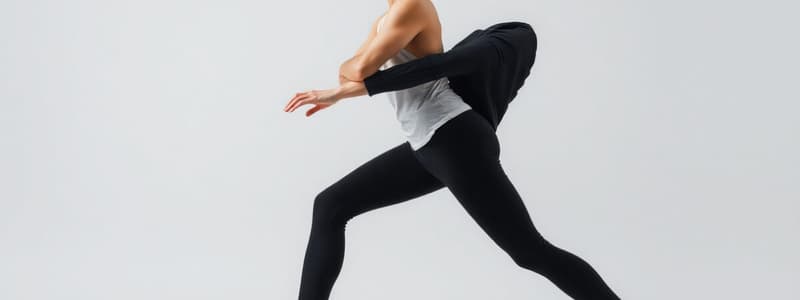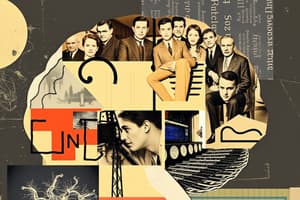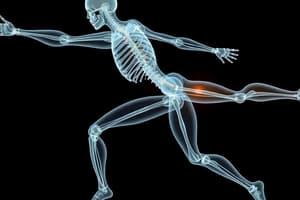Podcast
Questions and Answers
What defines stability in the context of body stability (BOS)?
What defines stability in the context of body stability (BOS)?
- Non-moving BOS (correct)
- Positioning the upper body
- Walking or running
- Dynamic movements
Which theory of motor control emphasizes the integration of reflexes as the basis of movement?
Which theory of motor control emphasizes the integration of reflexes as the basis of movement?
- Reflex Theory (correct)
- Motor Programming Theory
- Ecological Theory
- Dynamic Systems Theory
Which limitation is associated with Reflex Theory?
Which limitation is associated with Reflex Theory?
- It incorporates voluntary movement
- It explains complex, novel movements
- It accounts for variable responses to the same stimulus
- It cannot explain movements occurring without sensory input (correct)
What is a primary function of theories of motor control in clinical practice?
What is a primary function of theories of motor control in clinical practice?
What distinguishes manipulation movements from non-manipulation movements?
What distinguishes manipulation movements from non-manipulation movements?
What is a key cognitive factor in purposeful movement?
What is a key cognitive factor in purposeful movement?
Which system integrates sensory information into meaningful data during movement?
Which system integrates sensory information into meaningful data during movement?
What do the neural mechanisms for task categories such as stability and manipulation address?
What do the neural mechanisms for task categories such as stability and manipulation address?
Which component is NOT considered part of the action aspect of movement?
Which component is NOT considered part of the action aspect of movement?
What aspect of movement does cognition primarily encompass?
What aspect of movement does cognition primarily encompass?
What influences the 'degrees of freedom' in motor control?
What influences the 'degrees of freedom' in motor control?
What is one of the roles of the sensory/perceptual system in movement?
What is one of the roles of the sensory/perceptual system in movement?
Which of the following is NOT a factor affecting individual constraints in movement?
Which of the following is NOT a factor affecting individual constraints in movement?
What are the three factors that interact to emerge movement?
What are the three factors that interact to emerge movement?
Which statement best describes the nature of observed movement?
Which statement best describes the nature of observed movement?
How can one alter the individual factor to enhance a patient’s performance in sit to stand?
How can one alter the individual factor to enhance a patient’s performance in sit to stand?
In the context of movement analysis, what does the task factor involve?
In the context of movement analysis, what does the task factor involve?
What might be a consequence of having poor anticipatory balance control in sitting?
What might be a consequence of having poor anticipatory balance control in sitting?
Which approach focuses on analyzing movements based on individual, task, and environmental interactions?
Which approach focuses on analyzing movements based on individual, task, and environmental interactions?
To enhance a patient's ability to move from sitting to standing, which environmental change could be beneficial?
To enhance a patient's ability to move from sitting to standing, which environmental change could be beneficial?
What is the significance of the integration of theories from historical to current perspectives in movement analysis?
What is the significance of the integration of theories from historical to current perspectives in movement analysis?
What is the primary role of physical therapists in relation to motor control?
What is the primary role of physical therapists in relation to motor control?
Which of the following best defines motor control?
Which of the following best defines motor control?
Motor learning can be best described as what?
Motor learning can be best described as what?
What system integrates sensory information to control movements?
What system integrates sensory information to control movements?
What three factors are analyzed to understand movement patterns?
What three factors are analyzed to understand movement patterns?
Which system utilizes both action and perception for goal-directed movement?
Which system utilizes both action and perception for goal-directed movement?
What aspect does motor development primarily concern itself with?
What aspect does motor development primarily concern itself with?
How are motor control, motor development, and motor learning all interconnected?
How are motor control, motor development, and motor learning all interconnected?
What does the concept of reciprocity within a network of interneurons primarily involve?
What does the concept of reciprocity within a network of interneurons primarily involve?
What is meant by 'emergent properties' in the context of interneuron networks?
What is meant by 'emergent properties' in the context of interneuron networks?
How does Bernstein's theory describe the body's mechanical system?
How does Bernstein's theory describe the body's mechanical system?
What issue does the Degrees of Freedom Problem in Bernstein’s theory highlight?
What issue does the Degrees of Freedom Problem in Bernstein’s theory highlight?
What role do synergies play according to the concept in movement solutions?
What role do synergies play according to the concept in movement solutions?
What limitation is noted in Bernstein's theory regarding motor control?
What limitation is noted in Bernstein's theory regarding motor control?
What advantage does the concept of redundancy offer in motor function?
What advantage does the concept of redundancy offer in motor function?
How does control/command emerge according to system concepts?
How does control/command emerge according to system concepts?
What is the principle of self-organization in natural patterns?
What is the principle of self-organization in natural patterns?
How do non-linear properties affect organizational structures in dynamic systems?
How do non-linear properties affect organizational structures in dynamic systems?
Which of the following describes the interaction of the motor system with its environment?
Which of the following describes the interaction of the motor system with its environment?
What is a control parameter in a dynamic system?
What is a control parameter in a dynamic system?
In the context of dynamic systems, what is meant by stable and unstable states?
In the context of dynamic systems, what is meant by stable and unstable states?
Which theory applies thermodynamic principles to explain transitions in movement states?
Which theory applies thermodynamic principles to explain transitions in movement states?
What does ‘open systems’ refer to in the context of dynamic systems?
What does ‘open systems’ refer to in the context of dynamic systems?
What is meant by the term ‘synergy’ in movement patterns?
What is meant by the term ‘synergy’ in movement patterns?
Flashcards
Motor Control
Motor Control
The process that organizes, produces, and regulates posture and movement.
Motor Learning
Motor Learning
The process of acquiring knowledge about the world through movement.
Motor Development
Motor Development
The changes in motor behavior over the lifespan.
Movement System
Movement System
Signup and view all the flashcards
Action System
Action System
Signup and view all the flashcards
Perception System
Perception System
Signup and view all the flashcards
Cognitive System
Cognitive System
Signup and view all the flashcards
Constraints on Movement
Constraints on Movement
Signup and view all the flashcards
Movement Task
Movement Task
Signup and view all the flashcards
Individual Constraints
Individual Constraints
Signup and view all the flashcards
Environment Constraints
Environment Constraints
Signup and view all the flashcards
Mobility Task
Mobility Task
Signup and view all the flashcards
Stability Task
Stability Task
Signup and view all the flashcards
Task-Oriented Approach
Task-Oriented Approach
Signup and view all the flashcards
Movement emerges as interaction of three factors
Movement emerges as interaction of three factors
Signup and view all the flashcards
Individual (Person)
Individual (Person)
Signup and view all the flashcards
Task
Task
Signup and view all the flashcards
Environment
Environment
Signup and view all the flashcards
Anticipatory Balance
Anticipatory Balance
Signup and view all the flashcards
Weight Forward
Weight Forward
Signup and view all the flashcards
Force Production
Force Production
Signup and view all the flashcards
Stability vs Mobility
Stability vs Mobility
Signup and view all the flashcards
Manipulation vs Non-Manipulation
Manipulation vs Non-Manipulation
Signup and view all the flashcards
What does a theory provide?
What does a theory provide?
Signup and view all the flashcards
Reflex Theory
Reflex Theory
Signup and view all the flashcards
Limitations of Reflex Theory
Limitations of Reflex Theory
Signup and view all the flashcards
Reciprocity
Reciprocity
Signup and view all the flashcards
Distributed & Shared Function
Distributed & Shared Function
Signup and view all the flashcards
Emergent Properties
Emergent Properties
Signup and view all the flashcards
Command Flexibility
Command Flexibility
Signup and view all the flashcards
Redundancy
Redundancy
Signup and view all the flashcards
Degrees of Freedom Problem
Degrees of Freedom Problem
Signup and view all the flashcards
Synergies
Synergies
Signup and view all the flashcards
Bernstein's Theory
Bernstein's Theory
Signup and view all the flashcards
Self-Organization
Self-Organization
Signup and view all the flashcards
Non-linear Properties
Non-linear Properties
Signup and view all the flashcards
Dynamical Systems Theory (DST)
Dynamical Systems Theory (DST)
Signup and view all the flashcards
Open System
Open System
Signup and view all the flashcards
Closed System
Closed System
Signup and view all the flashcards
Control Parameter
Control Parameter
Signup and view all the flashcards
Stable Movement State
Stable Movement State
Signup and view all the flashcards
Unstable Movement State
Unstable Movement State
Signup and view all the flashcards
Study Notes
Motor Control
-
Motor control is the process of organizing and regulating posture and movement.
-
The goal is to understand how the central nervous system (CNS) coordinates muscles and joints for functional movements.
-
Sensory information from the environment and the body is used to select and control movement. This is known as the perception system.
-
Goal-directed movement within the environment requires a cognitive system.
Motor Learning
-
Motor learning is the process of acquiring knowledge about the world, focused on the capability to perform skilled actions.
-
It is a result of practice and experience, and produces relatively permanent changes in behavior.
-
It cannot be directly measured but inferred from behavioral changes.
Motor Development
-
Motor development is the emergence of posture, movement, and skill development in mobility and manipulation across the lifespan.
-
It is about how movement capabilities change over time and how skilled actions develop with increasing competence.
Time Scales
-
Motor development occurs over a longer time span than motor learning or control.
-
The three processes are related but have different time scales.
Components of Motor Control
-
Postural Control; involving factors such as vision, cortex, ventrolateral thalamus, basal ganglia, vestibular, brain stem/cerebellum, somatosensation, and spinal cord.
-
Movement Control; focusing on Mobility and Manipulation.
Posture and Movement
-
Posture and movement are opposite ends of a continuum. Posture is holding a body configuration (standing, sitting, kneeling), whereas movement is changing or transitioning between postures (discrete tasks like standing up) or between locations (e.g. walking).
-
Posture is described as static or sustained, with a stable BOS (base of support). Movement is dynamic, with a changing BOS.
Motor Control: Assumptions
-
Motor control, development, and learning are mediated by the nervous system.
-
Analyzing motor behavior provides an indirect study of brain function.
Theory and Practice
-
Contemporary practical perspective emphasizes a task-oriented approach to movement analysis, integrating historical theories with current knowledge.
-
Theories in motor control are not mutually exclusive.
Nature of Movement
-
Movement emerges from the interaction of three factors: the individual, the task, and the environment.
-
Observed movement results from the individual's capacity to interact with the demands of the task and the environment.
Theories of Motor Control
- Includes Reflex Theory, Hierarchical Theory, Motor Programming Theory, System Theory, Dynamic Systems Theory, Ecological Theory, and the Task-oriented approach.
Clinical Implications
-
Clinical evaluations rely on understanding reflexes to predict function.
-
Treatment strategies often aim to enhance or diminish reflexive behaviors to achieve functional tasks.
-
Functional training supports higher-level centers in regaining motor control.
Limitations in Theories
- Some theories have limitations in explaining voluntary movement, variability in response to stimuli, or the ability to generate novel movements. Theories may not consider the environment effectively.
Motor Program Theory
-
The motor system is not purely reactive but exhibits patterns of movement even without continued stimulus.
-
Central motor patterns (or motor programs) are stored and activated, more flexible than simple reflexes, for specific tasks such as writing a signature.
-
There are neural substrates involved in this process (called Central Pattern Generators).
Schmidt's Schema Theory
-
Memory structures (schemas) store rules for movement.
-
Invariant features remain constant across different scenarios; parameters adapt to specific situations, reflecting environmental adjustments.
Systems Theories
-
This approach emphasizes the interconnected nature of elements in a system, minimizing the concept of levels of control.
-
Features like reciprocity(interconnectedness) among interneurons, distribution of function to multiple neurons, and the emergence of properties are key concepts.
Ecological Theory (Perceptual Action Theory)
-
Actions are oriented according to task-specific environmental constraints.
-
It focuses on how the environment shapes actions.
Terminology Related to Non-Linear Transformations
-
Control parameter describes the factor that drives a system's change (e.g., changing speed on a treadmill).
-
Attractor states represent a more-preferred configuration reflecting movement patterns.
-
Affordance describes how the environment affects movement (what supports climbing).
Summary
-
The lecture covered different theories of motor control, learning, and development.
-
A contemporary model called the Task-oriented approach was presented, along with a review of historical theories.
-
Key terminology and clinical implications were highlighted.
Studying That Suits You
Use AI to generate personalized quizzes and flashcards to suit your learning preferences.




